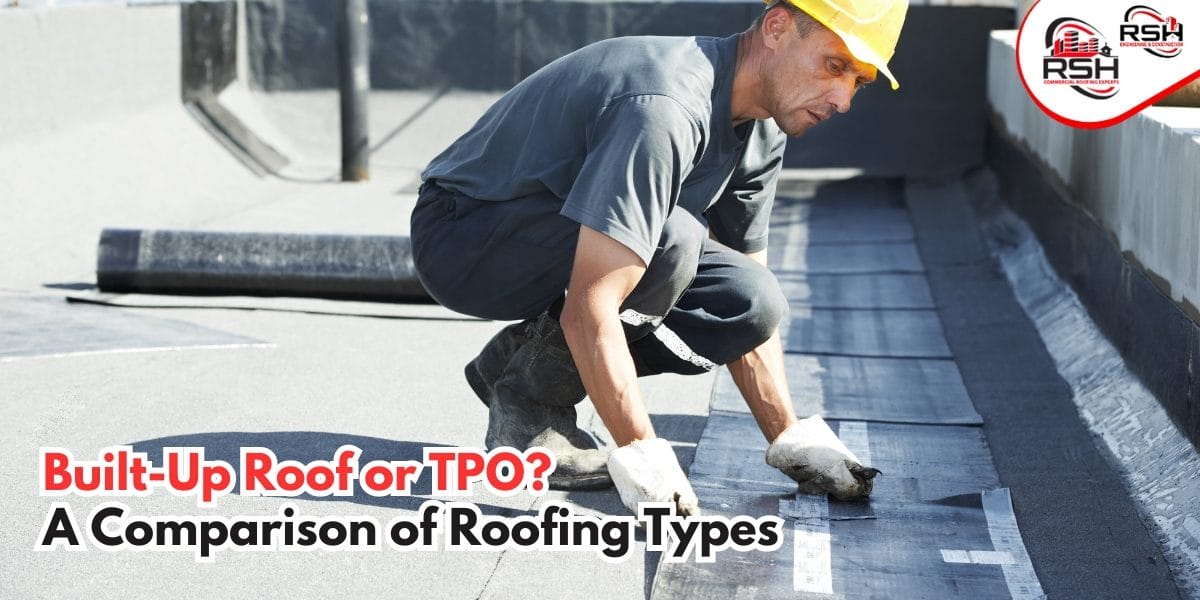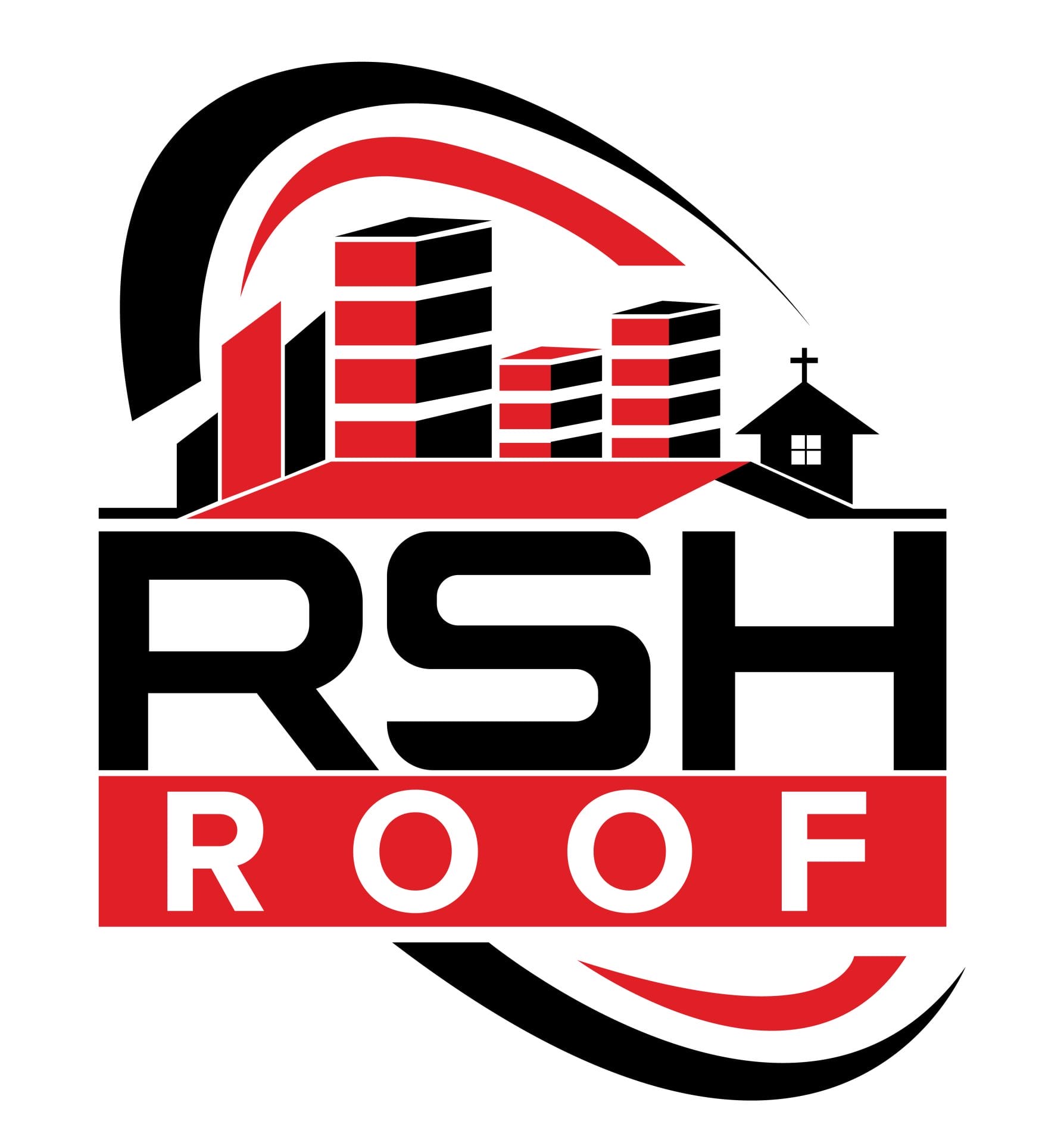RSH Commercial Roofing is a Professional Engineering & Construction Company with 25+ years of experience that specializes in Commercial & Residential Roof Inspections, Repair/Replacement services as well as commercial roofing insurance claims.

Built-Up Roof or TPO? A Comparison of Roofing Types
Introduction:
Choosing the right roofing material plays a necessary role in the longevity, performance, and energy efficiency of your home’s roof. The two better options that often come up in discussions are Built-Up Roof or TPO.
In this comprehensive blog, it carries the details of roofing type, supplying a build-up of roofs versus TPO comparison, and a thorough discussion of various other roofing types. Don’t wait, let’s get proper maintenance of the roof now with the help of RSH Roof Services!
Understanding the term built-up roof or TPO
What is a built-up roof?
A built-up roof in an abbreviated form known as BUR, is a traditional roofing system that has been in use for over a century. It is composed of multiple layers of bitumen (asphalt or coal bar) covered with reinforcing fabrics, giving a durable, watertight seal.
The top layer consists of gravel or a cap sheet, which protects the layers underneath from UV rays and weather damage.
Benefits of built-up roofs:
The built-up roofs consist of various benefits in themselves. The list includes the points:
- BUR systems have the feature of robustness, which is retained for over 20 to 30 years with proper maintenance.
- It carries multiple layers and acts as a barrier to prevent waterproofing.
- The top layer of BUR offers an additional advantage of fire resistance.
- BUR has a long track record of reliability and effectiveness.
What is a TPO roofing?
The TPO roofing or Thermoplastic Olefin (TPO) is designed as a single-ply membrane made up of a blend of polypropylene and ethylene-propylene rubber.
TPO roofing carries the features of energy efficiency, durability, and ease of installation, which is a popular choice for both residential and commercial applications.
Benefits of TPO roofing:
The benefits of TPO roofing consist of:
- TPO layers are highly reflective, therefore it reduces the cooling costs by reflecting UV rays.
- They are lightweight and easy to install on roofs and can reduce labor costs.
- TPO is good in the feature of durability and reduces the cause of tears, punctures, and impact damage.
- You can recycle the TPO, as it does not contain chlorine, making it an eco-friendly option.
- TPO is generally more affordable as compared to other roofing materials like EPDM or PVC.
Built up roof vs TPO comparison: A deep difference
A thorough comparison of built-up roof or TPO brings you the perfect differences between them, and also helps you to give a better choice of which built up roof vs TPO comparison suits your property:
Roofing material comparison:
Installation:
- BUR: BUR consists of multiple layers, which is time-consuming and labor-intensive.
- TPO: TPO membranes are quickly installed and are lightweight roofing material comparison, as they consist of a single layer.
Cost:
- BUR: Generally it is more expensive due to the required materials and labor involved.
- TPO: It is cost-effective, in terms of materials and installation.
Energy efficiency:
- BUR: Made up of gravel top which offers UV protection quality but not much as TPO does.
- TPO: TPO is a highly reflective material, reducing cooling costs significantly.
Durability:
- BUR: BUR can be sustainable for at least 20-30 years.
- TPO: TPO can be sustainable for at least 20-25 years because it is resistant to punctures and tears.
Maintenance:
- BUR: Requires minimal maintenance but can be challenging to repair if leaks occur.
- TPO: Easy to maintain and repair due to its single-ply design.
Environment impact:
- BUR: Uses bitumen containing types of roofing materials, which is created from petroleum, therefore making it less eco-friendly.
- TPO: TPO is easy to recycle and does not contain any harmful chemicals making it greener.
Types of roofs:
Keeping side to BUR and TPO, there are also other popular roofing types available which are characterized by their specialty and drawbacks, these are:
Asphalt shingles:
- Used for residential roofs, these are affordable and easy to install. They come in a variety of colors.
- Lifespan: Asphalt shingles are retained for over 15-30 years.
Metal roofing:
- As the name says “Metal” these are metal roofings especially installed in both residential and commercial buildings. They are extremely durable, fire-resistant, as well as energy-efficient.
- Lifespan: Metal roofing is sustainable for 40-70 years on the roof.
EPDM roofing:
- Used in commercial flat roofs, and is easy to install.
- Lifespan: They retain their freshness for 20-30 years.
Slate roofing:
- Slate roofing is preferred for high-end residential properties, it is also called long-lasting roofing.
- Lifespan: They are sustainable for 50-100 years.
What is the role of roof contractors and roof repair specialists?
Getting or hiring a professional roof contractor is a tough task, ensuring the longevity and performance of your roofing system. Here’s what you need to do when stepping in to hire experienced roof contractors:
Role of roof contractors:
- Roof contractors play their role in necessary skills and have experience in installing various types of roofing material correctly.
- Professional contractors use high-quality materials and adhere to industry standards.
- Many contractors offer warranties when hiring them for work, this gives a relief of peace.
Working with roof repair specialists:
- Doing regular roof maintenance can lead to minor issues becoming major problems.
- The roof repair specialist quickly addresses leaks, punctures, and other damages to extend the life of the roof.
- The periodic inspections help to identify potential issues early, allowing you to save your money.
What is roof maintenance?
The term “Roof Maintenance” allows for maintenance of the performance and longevity of residential/commercial roofs. The below provides some tips to maintain your roof for a longer duration:
- Schedule regular inspections by hiring a roof repair specialist to examine any issues before.
- Keep the system of gutters clean to prevent water buildup and damage.
- Regularly remove leaves, branches, and other debris from your roof to prevent defacements.
- Always check the signs of any damage, such as cracks, blisters, or punctures, and gently fill these damages.
Conclusion
It’s tough to choose an appropriate and existable roof for your residential or commercial buildings, but it becomes easy when some roof repair specialists or roof contractors suggest you go with the option of either a Built-Up roof or TPO, and so on. Worry not! Now it’s easy to select a roof with the features of durability and excellent waterproofing. Yes, with the guide of RSH Roof Services.
Take a break and give a thorough understanding of the guide above, which helps you to clear most of the problems related to roof installation and maintenance.

